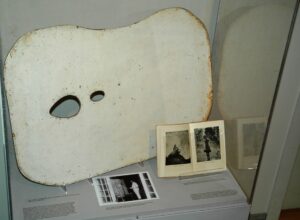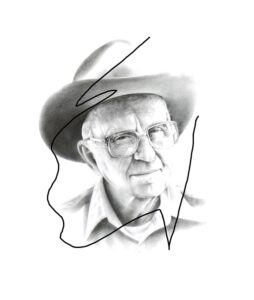Daniel Garber’s Life Within The Archives


There are tons of fascinating finds within the Michener’s archives. From sketchbooks to photographs, one can gather an extensive amount of information (and all from primary sources!). Outside of the archives and library are a few display cases that highlight some of the collections treasures. It is here that one of Daniel Garber‘s painting palettes is displayed. But this isn’t the only “artifact” of Garber’s that the Michener has. Along with various documents, the archives has another palette, a collection of his paint brushes, and his painting smock. These might seem like traditional items that all artists might have, but with a little research, it is interesting how these objects begin to represent Garber, his life, and artistic style.
There is a lot of information that we can learn from in looking at Daniel Garber’s palettes. The advent of the paint tube in 1841 allowed artists to stop mixing their own paint and opened up many doors for painters! Many impressionists of that time, including well noted artists like Monet and Renoir, began to paint “en plein air,” a french term meaning “outdoors” or “in the open air”. This versatility was imperative for the impressionist movement as it allowed painters to study nature, light, and its affects on our eyes without the constraint of having to paint indoors. Working in an impressionist manner, Garber was no stranger to working “en plein air,” and in fact, he embraced it. Even though the palettes are directly linked to this technique, it still reminded me of Garber’s interest in painting outdoors. Many times he would travel around Bucks County with his truck to find ideal spots to paint. By painting “en plein air,” Garber would take his time observing nature and painting it just as he interpreted it. But Garber was an artist who also worked in the studio at his home in Cuttalossa. His noted mural, A Wooded Watershed, was one of these works executed in only six weeks!
Garber’s smock reminded me not of his role as an artist, but instead, as an educator. For a little over forty years, Garber taught at the Pennsylvania Academy of Fine Arts, an institution where he had studied. On many accounts, it is said that Garber was an influential teacher and many students appreciated learning from him. But, apparently Garber was unconventional in his approach. During his classes, every Thursday was considered “Garber Day.” One of his students, Francis Speight, commented on these lessons:
He [Garber] would walk over to where a student was drawing. The student would get up out of his chair, Mr. Garber would sit down in the chair, look at the cast that was being drawn and at the drawing…Then he would make some clear and decisive lines of correction. Then he would talk to the student a bit, modulating his voice to suit the merits of the drawing. Then he would go on to the next student while sometimes the student whom he had just been criticizing would leave the class for a breather, and sometimes, though rarely, to shed a few tears.
Despite the occasional severity in his instruction, Garber was well loved by his students and considered the heart of the academy. Now where does the smock come in exactly? It was part of his traditional teaching attire consisting of knickerbockers, a shirt, and bow tie.
I have only connected these archival items to just two facets of Daniel Garber’s life, but they can apply to so many more. After all these are the essential tools for all artists. But it is amazing that these items can become so much more than a palette or smock; they become a symbol to the life of one of Pennsylvania’s greatest painters in our region. How cool is that?!
What do you think? Do you think these items represent another component of Garber’s life? Or maybe even a painting of his? Share your thoughts in the comment section!
-Taylor Hunkins, Michener Art Museum Intern